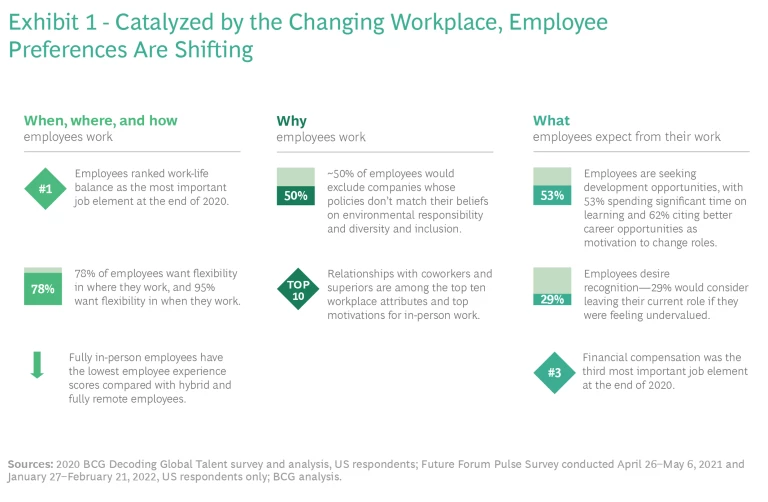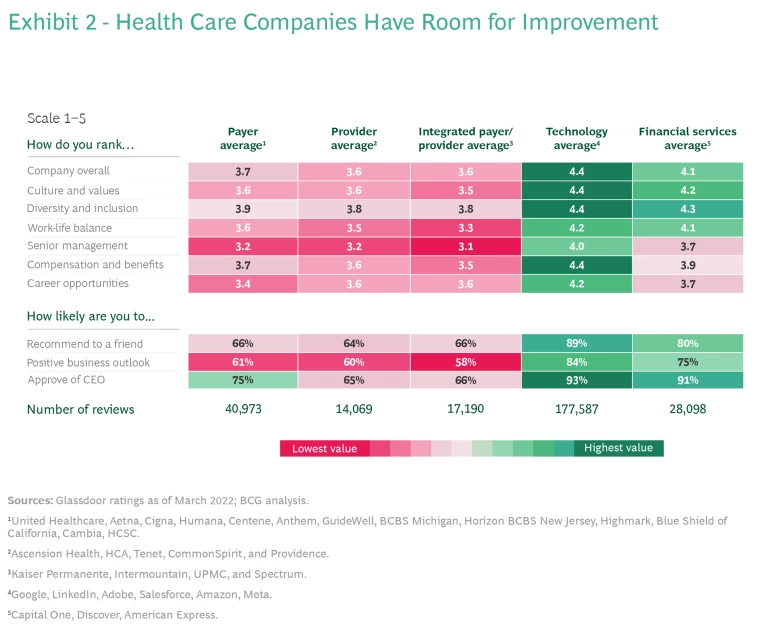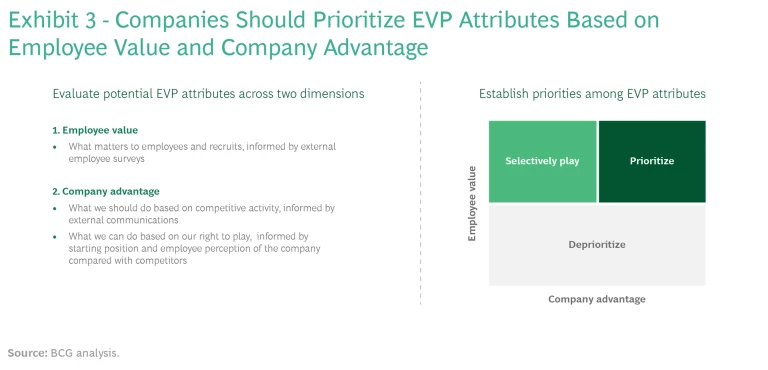An employee value proposition can help companies keep current employees and attract new ones.
Companies in the health care industry have an imperative to renew their employee value propositions (EVPs)—the tangible and intangible commitments an organization makes to its people in the form of compensation, rewards, culture, and other offerings. All workplaces are experiencing significant change brought on by the pandemic, technology, demographics, industry consolidation, and sharpened social awareness. Health care companies specifically are undergoing dramatic industry change and facing new competition. An EVP can help these companies keep current employees and attract new ones.
Payers, providers, pharmacy benefit managers, and health care services companies are merging, bringing together distinct employee groups. At the same time, advances in treatments, data and analytics, technology, and consumer expectations are creating the need for new skills. Companies need to hire talent who can design solutions that bridge the worlds of health and technology: data-enabled care management programs, personalized patient engagement campaigns, digital care delivery channels, and so on.
In this new world, health care companies are more than ever competing for talent with companies from other industries. They also need to respond to increasing employee demands for flexibility and work-from-home options.
At its best, health care is a purposeful and resourceful industry filled with people who want to save lives and improve health. That’s a strong starting point from which to create an EVP that excites employees and attracts skilled candidates not just in digital roles but also in traditional roles such as nurses, doctors, strategists, and product developers. But in a hyper-competitive labor market, past reputation and success are not enough. Even seasoned employees have higher expectations of work and employers than just a few years ago.
Companies with well-designed EVPs benefit from stronger and larger candidate pools, faster hiring, and higher acceptance rates. Employees are more deeply engaged, leading to greater productivity. And good EVPs also lower turnover, which is both costly and disruptive. (Experts estimate the cost of turnover for midlevel employees can be as high as 1.5 times their salary at health care companies.)
The Changing Workplace
The workplace in health care and all other industries is undergoing a transformation as dramatic as the rise of industrialization more than century ago or the entry of women into the labor force after World War II. Four forces explain the transformation.
COVID-19. The extraordinary conditions created by the pandemic dramatically revealed the industry’s strengths and weaknesses. As companies try to bring people back to offices, they are running into new employee expectations. More than a third of knowledge workers are now working from the office full-time, reports the Future Forum, a future of work consortium of which BCG is a member. These in-person employees are less happy and have higher levels of work-related stress and anxiety, compared with those working remotely or in hybrid arrangements, according to a 2022 survey of 10,000 knowledge workers in Australia, France, Germany, Japan, the UK, and the US.
Social Awareness. Employees increasingly expect their employers to demonstrate a commitment to racial and social equity and the environment. Governments, investors, consumers, and NGOs have also been pressuring companies to become environmentally responsible and sustainable.
Technology. Digital tools have enabled remote work and created intelligent physical workspaces.
Demographics. Despite a brief uptick in 2021, the US birth rate has been declining for decades along with workforce participation. Both factors are contributing to the shortage of workers for many companies.
New Employee Preferences
Employees have far different views of their work and aspirations than pre-pandemic three years ago. And their conception of and relationship to their jobs continue to evolve rapidly.
- When, where, and how employees work. Employees want flexibility. The recent Future Forum survey found that 78% of US knowledge workers want location flexibility and 95% want scheduled flexibility.
- Why employees work. Fifty percent of employees would not work for companies whose policies don’t match their beliefs on the environment, diversity, and inclusion.
- What employees expect from their work. Employees are seeking development opportunities, with 53% already spending significant time on learning and 62% citing better career opportunities as a motivation to change jobs. Employees also desire recognition—29% would consider leaving a job if they felt undervalued. (See Exhibit 1.)
In addition, employees who work for health care companies have specific concerns about who they work for, according to a BCG analysis of employee ratings on Glassdoor, the online employer review site. Employees in the health care industry were less satisfied than their peers in technology and financial services on a range of attributes such as culture and values, career opportunities, and work-life balance—attitudes that an EVP can address. (See Exhibit 2.)
The Promise of Employee Value Propositions
The Glassdoor ratings should be a strong signal to health care companies that they have work to do in improving their EVP. A company’s proposition should be tailored to different employee groups and include a wide range of considerations beyond compensation and benefits. In creating an EVP, most companies will review the following broad attributes:
- Mission. The purpose of the company and what it stands for—the attributes that get people excited to go to work in the morning
- Opportunities. Career advancement, training, development, job rotations, personal challenge and growth—and the opportunity to work with curious, caring people
- Working conditions. Innovation, work-life balance, minimal bureaucracy, flexible work hours, and remote or hybrid work—the things that mattered so much during the pandemic
- People. Senior leadership reputation, diversity, and behavior—the ability to work with people you respect and whose values you share
- Rewards. Salary, variable compensation, and benefits—the “hard” components of an EVP that still matter
- Culture. Meritocracy, collaboration, entrepreneurship, and other attributes—the way work gets done at the organization
It might be tempting to play follow the leader and simply reproduce a package of benefits and attributes that others in the market or industry are offering. Unfortunately, the task is not so simple. A health care company is competing for talent not only against peers in its industry and geographic market but also against companies sourcing similar talent—a data scientist can work for a bank as easily as for a health care company. An EVP should also speak directly to the essence of a company, and that will vary even within the same market or industry.
Health care companies should understand what attributes matter to their employees, what their competitors and peers are offering, what offerings are table stakes, and where they can be differentiated. And it is important to recognize where employers cannot compete. A local health system, for example, cannot offer global opportunities.
Most health care companies do not have the resources to invest fully in every attribute employees desire. They should identify those that are most important to workers and that are competitive sources of strength for the company. Organizations can then selectively invest in attributes that employees care about but are relative gaps for the company today. Finally, they should not prioritize investment in or communicate those attributes that do not matter to employees. (See Exhibit 3.)
Just because employees say in a survey they want a certain benefit does not mean they will actually use it. Companies should design a set of promising initiatives so that they can test and refine what they offer their employees. Flexible work schedules, for example, come in many flavors, and companies are unlikely to design the ideal flexible work package on their first attempt.
Once a company has developed and pressure-tested a set of initiatives and attributes, it needs to communicate the new EVP to employees and develop an implementation, socialization, and branding plan. An EVP will be only as good as the work that the organization invests in building awareness of it and putting it into action.
How Health Care Companies Can Start
Health care companies have a good story to tell employees and recruits about purpose and mission. Many have strong reputations based on groundbreaking research, world-class medical care, and top-ranked programs. All health care companies can emphasize their commitment to improve health within their communities. They can also tie that commitment to concrete actions, such as investing in housing, providing employment opportunities in less-advantaged communities, and improving the social and physical environments of vulnerable populations. These organizations can also use their recent investments in technology and innovation to demonstrate their commitment to creating health care that is affordable, high-quality, and accessible.
Health care companies have a great opportunity to refresh their employee value proposition and attract, retain, and develop the best talent. They can get started by following a four-step process:
- Create a fact base showing the attributes that employees are satisfied or dissatisfied with, attributes that potential recruits value, and those that competitors are offering.
- Build a fact-based, aspirational, authentic, and crisp EVP that resonates with your people.
- Develop a set of supporting initiatives and allocate sufficient resources to bring the new EVP to life.
- Embed the new EVP in the organization through disciplined execution of these initiatives and a complementary internal and external communications plan.
With the health care industry in such flux, a powerful EVP can signal a company’s commitment to its people and their ability to be an enduring source of competitive advantage. It can also immediately start to see benefits of increased retention and faster hiring.









